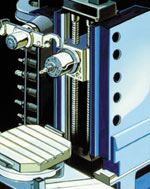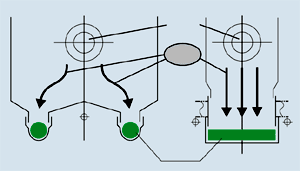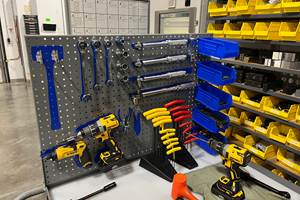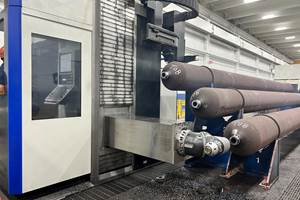Are Two Ballscrews Better Than One?
A dual ballscrew arrangement on the Z axis leaves the middle of the base open for chip evacuation, solving the problem on table feed Z-axis, horizontal machining centers.
Share




Efficient chip evacuation from horizontal machining centers is a headache for most shops. In general, efforts to automate chip removal often involve augers and flush systems designed to move chips along the outside edges of the work zone and eventually out of the area into a chip conveyor for disposal.
Toyoda Machinery USA (Arlington Heights, Illinois) has come up with what it feels is a good solution to the chip evacuation problem on table feed Z-axis, horizontal machining centers.
Most HMCs of this type use a configuration composed of a set of ways running along the side of the Z axis base structure with a ballscrew centered between them. In this design, use of the middle of the base structure for chip evacuation is precluded because the ballscrew passes through it. Therefore chips must be pushed to either side of the base for evacuation. The way covers and ballscrew covers are pitched, like a roof, to help direct the chips to the sides of the base. From there they are moved with augers or washed to a chip conveyor.
What Toyoda has done is create a center through-hole base so chips fall directly into a large capacity chip conveyor that exits the rear of the machine. The chip conveyor slides under the machine base occupying the space between the ways.
So where’s the ballscrew? Actually there are two ballscrews on this design. In order to balance the movement of the Z-axis carrier, a ballscrew is located on the right and left sides of the carrier parallel to the ways. This leaves the middle of the base open for chip evacuation.
The enabling technology for this design is a feature on the Fanuc 16i CNC called tandem control. This allows the dual axis ballscrews to perform in synchronized fashion so one or the other can’t try to skew the work table carrier.
In operation, one of the two identical AC servomotors driving the ballscrews functions as the “master,” and the other is the “slave.” The master motor controls the axis movements, while the slave motor follows.
Parallel performance is monitored and adjusted by the CNC, which reads the electrical current of the slave motor. If the current of the slave motor goes up, a signal from the control is sent so the slave self-adjusts to compensate. Synchronization is maintained.
At start-up, the Z axis is automatically “homed” using the master motor’s absolute position encoder, and the slave motor is synchronized off this position. Generally, no further mechanical alignment or adjustment is necessary between the two motors. However, should the machine need to be reset, homing the master axis drive will automatically re-synchronize the motors.
Toyoda has also applied dual ballscrews, in combination with the Fanuc 16i tandem control feature on the Y axis of its FA 800 horizontal machining center. In this case, the dual ballscrews eliminate the need to counterbalance the spindle carrier. The load of the carrier is shared between the two ballscrews, which, the company says, increase responsiveness of the axis for high-speed acceleration and rapid traverse rates.
If one ballscrew is good, two are better? That seems to be the case on these machining centers. MMS
Related Content
Translating a Prototyping Mindset to Production
The experimental mindset that benefited BDE Manufacturing Technologies as a prototype job shop has given it an adaptable edge as a production facility.
Read MoreGrob Robot Cell Enables Long Periods of Unmanned Operation
The GRC-R12 robot cell features a pneumatic single- or double-gripper system, as well as a drawer feed system with six drawers.
Read MoreLarge-Format Machining Simplifies Tube Manufacturing
Downtime is the enemy of efficient manufacturing — a problem FIBA Technologies has addressed through purchasing a Soraluce FLP 14000.
Read MoreNavigating Large-Scale CNC Machining: Suburban Tool’s Niche Strategy to Stay Competitive
Facing increasing competition from lower-cost imports, Suburban Tool made a move toward large-scale, in-house machining. By identifying a niche in large, precision angle plates and tombstones, the company has strengthened its ability to control quality and protect its reputation.
Read MoreRead Next
Registration Now Open for the Precision Machining Technology Show (PMTS) 2025
The precision machining industry’s premier event returns to Cleveland, OH, April 1-3.
Read MoreSetting Up the Building Blocks for a Digital Factory
Woodward Inc. spent over a year developing an API to connect machines to its digital factory. Caron Engineering’s MiConnect has cut most of this process while also granting the shop greater access to machine information.
Read More5 Rules of Thumb for Buying CNC Machine Tools
Use these tips to carefully plan your machine tool purchases and to avoid regretting your decision later.
Read More


































.jpg;maxWidth=970;quality=90)